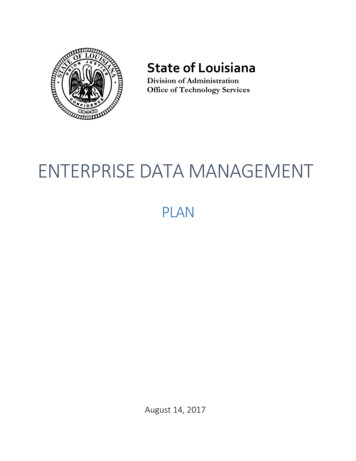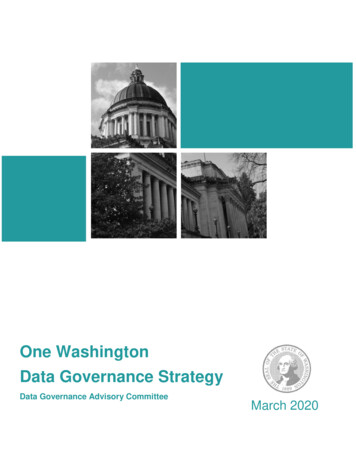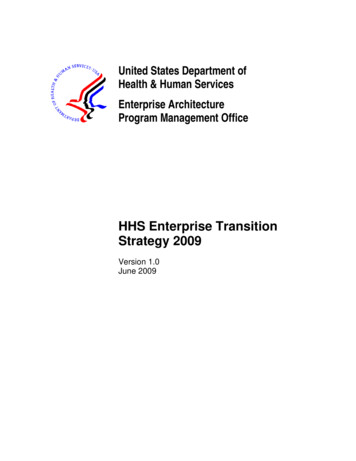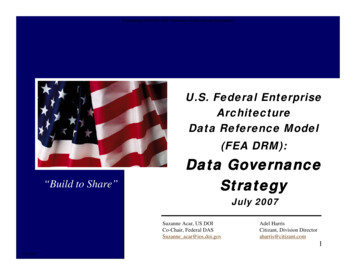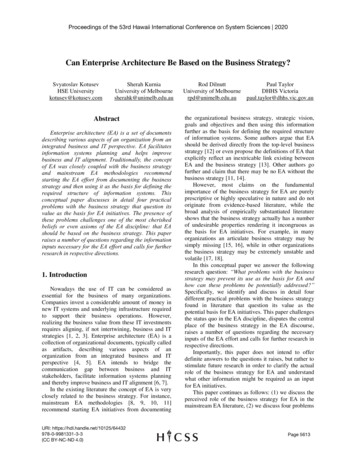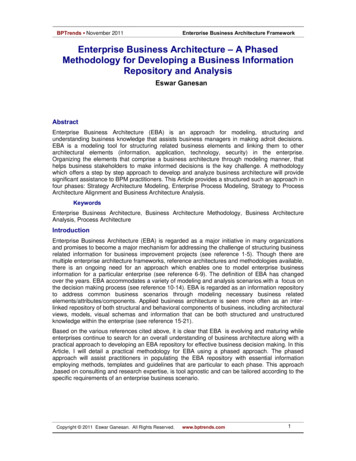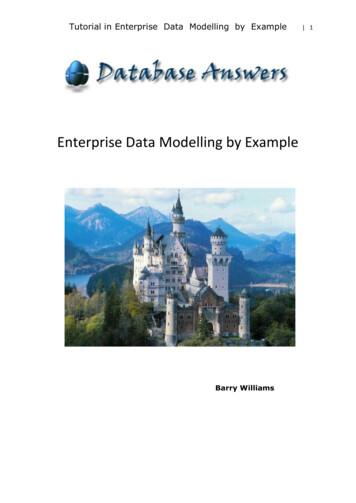
Transcription
EnterpriseData StrategyEmpowering Data Informed DiplomacySEPTEMBER 2021
Table of ContentsLetter From The Deputy Secretary of State for04Management and ResourcesU.S. Department of StateExecutive Summary05Introduction07Strategic Drivers for a Data-Centric Department08Department of State Data Vision09Goals and Objectives11Goal 1: Cultivate a Data Culture12Goal 2: Accelerate Decisions through Analytics13Goal 3: Establish Mission-Driven Data Management14Goal 4: Enhance Enterprise Data Governance15Guiding Principles16Moving Forward17Enterprise Data StrategyPage 2
U.S. DEPUT Y SECRETARY OF STATE FORMANAGEMENT AND RESOURCESB R I A N P. M C K E O NWhen our foreign affairsprofessionals are equipped with highquality and timely data, we can makethe world safer, more just, andless divided.
Enterprise Data StrategyEmpowering Data Informed DiplomacyA letter from the Deputy Secretary of State forManagement and ResourcesTo lead America’s foreign policy in the 21st century, we must be fully prepared for thechallenges, both seen and unseen, that lie before us. As the leader of our country’sresponse to these challenges, the Department of State must leverage data as a criticalinstrument of diplomacy. When our foreign affairs professionals are equipped with highquality and timely data, we can help make the world safer, more just, and less divided.Data has already transformed the global landscape, in both life-saving and lifethreatening ways, and it is our responsibility to be a world leader in harnessing its powerfor the good of the American people and the broader international community. As artificialintelligence empowers governments to analyze data at scale and reevaluate how theyprovide services, regulate industries, and protect their citizens; we will all grapple withthe resulting ethical and accountability challenges. Yet, as with all paradigm shiftsaffecting global economics, culture, human rights, and security, the Department of Statemust be at the forefront of these issues to ensure the safety and prosperity of theAmerican people.To use data as a strategic asset, we must first empower the Department’s greatestresource: its world-class global workforce. Our people require accurate data at theirfingertips, where they are and when they need it. To thrive in this data-powered world, ourteam needs the skills, expertise, and tools to turn data into insights. To be sure, thismindset calls for a culture change in the Department—one that has already begun. Wemust continue to invest in recruiting, training, and equipping our teams to be skilled dataconsumers and users. This will take time, but we have none to waste.The Department’s first-ever enterprise data strategy represents the dedicated efforts of adiverse team across the Department of State and will guide our digital transformationefforts in the years to come. I would like to sincerely thank all the hardworking membersof our Department family who made this effort possible, from the experts who dedicatedtheir time in one-on-one interviews and focus group sessions to influence the strategy’sgoals, to the leaders on the Enterprise Data Council that have come together to forge aunified vision of data at State. And special thanks to the Office of Management Strategyand Solutions and to the Center for Analytics, which will be supporting the experts andleaders across the Department in achieving our collective data vision in the years tocome.I look forward to collaborating with all our bureaus, our workforce, and our interagencypartners in implementing this strategy and advancing foreign policy through data. TheDepartment’s mission—to advance the interests of the American people, their safety andeconomic prosperity—cannot succeed without it.Brian P. McKeonU.S. Deputy Secretary of Statefor Management and Resources RETRE TURURNN TOTO TATABLE OF CONCONTTENENTTSU.S. Department of StateEnterprise Data StrategyPage 4
Executive SummaryAmerica faces an evolving global landscape; threats to America’s prosperity, values,and security are rapidly changing and affect country, regional, and international contextsdynamically. The pace of America’s diplomacy must adapt to meet the speed of theseeverchanging geopolitical trends.We have the most advanced diplomatic corps in the world, and it is imperative that we matchthe excellence of our global workforce with excellence in our data-driven insights. Advancedanalysis must act in support of diplomacy, putting evidence-based insights at our professionals'fingertips to help them achieve their mission. Likewise, to streamline the delivery of ouroperations, we must use data to provide enabling services more nimbly and expeditiously.In the last decade, the private sector has continued to accelerate the pace of technologicalinnovation, putting highly advanced technology in the hands of individuals, companies, andgovernments around the world. While it has created enormous opportunities to transformthe way America conducts its affairs, it has also provided those same opportunities to ouradversaries. New technology alone will not solve our problems, but it is a vital component tousing data for diplomacy.These three drivers—an evolving global landscape, the need for data-driven insights, andan increase in the pace of technological innovation—necessitate an enterprise approachto modernizing the way the Department uses data as a strategic asset. This enterprise datastrategy provides the Department-wide approach to adapting to these drivers over the nextthree years.The creation of this strategy and its resulting initiatives will transform how the Departmentcollectively manages and applies data across all its mission areas. The strategy is groundedin a Vision that provides strategic coherence and alignment for the Department’s effortsto improve data maturity and capabilities, with Goals and Objectives that serve as targetsto achieve this Vision. The Department’s five Guiding Principles serve as our North Star toreinforce decisions around our data (Figure 1). Going forward, these elements will inform animplementation plan that will outline critical activities to execute this strategy.This strategy represents the close collaboration of bureaus and offices across the Departmentto develop a holistic approach to building a foundation of data capabilities and assets. As theDepartment’s first data strategy, it is a critical step toward improving our ability to use datato inform diplomacy while upholding the highest levels of scientific and data integrity. Thisstrategy, and a following implementation plan, are set on a three-year time horizon to createmomentum, deliver rapid return on its efforts to support the Department’s workforce, andprovide accountability to American taxpayers.We have the most advanced diplomatic corpsin the world, and it is imperative that we matchthe excellence of our global workforce withexcellence in providing data-driven insights. RETURN TO TABLE OF CONTENTSU.S. Department of StateEnterprise Data StrategyPage 5
Figure 1VISIONData is a critical instrument of diplomacy, theDepartment’s global workforce is empowered with the skills andtools to derive actionable mission insights from data, and its dataassets are securely sharedand effectively managed.GOALS & OBJECTIVES1234CULTIVATEA DATAGOVERNANCE1.1 Strengthen Data Fluency1.2 Enhance Data Collaboration1.3 Hire for the Future2.1 Deliver Analytic Products2.2 Provide ModernAnalytic Tools2.3 Pilot and Scale AI andML Applications3.1 Enable Access to Data3.2 Define Data Architecture3.3 Define and ImplementData Standards3.4 Establish DataQuality Program4.1 Institute Data GovernanceOperating Model4.2 Develop Data Policy4.3 Measure theOrganizational Value ofData and AnalyticsGUIDING PRINCIPLESSHAREDAPPLIEDGOVERNEDETHICALSECUREData is appropriatelyshared across theDepartment throughcollective stewardship toenable analysis acrossthe enterprise andenhance its value.Data is broadlyunderstood and appliedto inform evidence-baseddecisions at alllevels and missionsacross the globe.Effective oversightand management ofdata enables theDepartment’sapplications throughimproved data quality,simplified use, andinvestment decisionsprioritized by missionimpact.Data is responsiblycollected, stored, andutilized to provideaccountability to the U.S.taxpayer and uphold thehighest levels of scientificand data integrity.Data is safeguardedthrough industry leadingsecurity practices ateach classification levelto protect U.S. nationalinterests at home andabroad. RETURN TO TABLE OF CONTENTSU.S. Department of StateEnterprise Data StrategyPage 6
IntroductionThis enterprise data strategy represents theelevation of data in American diplomacy at a timewhen the world demands it, diplomacy calls forit, Ambassadors and other Department leadersrequire it, and our workforce expects it. Datarepresents an essential tool to maintain theUnited States’ competitive advantage on therapidly evolving global landscape. Diplomacy canbe more effective with comprehensive, timely, andaccurate data and intuitive analysis. With theexponential growth in the magnitude, velocity, andcomplexity of data, the Department’s ability toleverage innovative technologies to harness data’sfull potential will increase our capacity to advancethe interests of the American people their safetyand economic prosperity.The Department's distinct role in foreign relations,with embassies and consulates in 191 countries,means it collects and generates unique datafrom day-to-day diplomatic, assistance, andsecurity activities. This data not only informs ouroperations but is also vital to our interagencyand foreign partners. As America’s allies andadversaries invest in data collection, analysis,and enabling technologies, the Department,too, must develop its own strong and securedata capabilities and cultivate a data-fluentworkforce to respond to the world’s most pressingchallenges.Applied data and analytics also enable theDepartment’s goals of ensuring the transparent,effective, and efficient use of resources, asdescribed under Goal 4 of the FY 2018-2022Department of State and U.S. Agency forInternational Development (USAID) Joint StrategicPlan (JSP). As a responsible steward of taxpayerdollars, the Department remains committed tooperational excellence and must leverage datato appropriately assess program effectiveness,pinpoint and mitigate areas of risk, and providetransparency to the public. This intentional use ofdata can provide decision-makers and the publicalike with not only answers to critical questionsabout U.S. influence overseas – What are wedoing, and where are we doing it?– but it can alsoallow us to answer more useful questions – Howeffective are we, and how can we do better?To guide the Department in executing its missionboth effectively and efficiently, this enterprisedata strategy must align our data and analyticsactivities and accelerate the delivery of dataand insights to decision-makers at all levels ofthe Department. This strategy is the product ofclose collaboration of stakeholders across theDepartment. Leaders and data practitionersfrom over 20 bureaus and offices participated inworking sessions and reviews to identify commondata challenges and define the Vision, Goals,Objectives, and Guiding Principles required toshape the Department’s data-driven future. Aswe move toward implementing this strategy,the Department will build from its current dataleaders to extract best practices and securelyscale up existing efforts for impactful enterprisedeployment.To sustain meaningful progress, a follow-onimplementation plan will outline ownership andresponsibilities for monitoring, reporting, andevaluation of the execution of this strategy.The Department’s ability to leverageinnovative technologies to harness data’s fullpotential will increase our capacity to advancethe interests of the American people theirsafety and economic prosperity. RETURN TO TABLE OF CONTENTSU.S. Department of StateEnterprise Data StrategyPage 7
STRATEGIC DRIVERSfor ad ata - c e n t r i cDEPART MEN T
This is not only an opportunity,but a requirement for the United Statesto maintain its diplomatic edgeon the global stage.Changing global realities drive the need for DataInformed Diplomacy. As new actors and trendsproduce a rapidly evolving global landscape,the demand for data-driven insights from ourworkforce increases to keep pace with shiftingmission needs. Additionally, technologicalinnovation has created the opportunity to equip ourworkforce with the right data when they need it.Evolving Global LandscapeThe rapidly evolving global landscape acceleratesthe pace of international events and requiresincreasingly nuanced diplomatic action. TheDepartment must consider and coordinate withdiverse state and non-state actors with their owninterests, relationships, and data. Additionally, thedigital age represents a tremendous opportunityto share information and connect across historicaldivides. Yet, adversaries increasingly weaponizetechnology through misinformation, cyberattacks, and digital surveillance to spread technoauthoritarianism and promote anti-democraticagendas. To counter these trends, our diplomacymust be multi-faceted, encompassing a widerange of issues, such as human rights, economicinitiatives, and security assistance. U.S. diplomacymust be cross-functional, nuanced, and fast,delivering results for its people at the pace of globalevents.Demand for Data-Driven InsightsAcross the Department, stakeholders are demandingmore data analysis to help achieve their policyand management goals. These demands spaninternal operational effectiveness and criticaldiplomatic engagement. Senior Department officialsand executive leadership from partner agenciesincreasingly seek insights to inform evidence-baseddiplomatic, security, economic, and human rightspolicy decisions. At the working level, the workforcedemonstrates a broad and increased interest inproducing and consuming data, as exhibited bythe nearly 900 dashboards for over 45,000 usershosted by the Department in just one of its datavisualization platforms. The Department mustsupport this growing appetite for data analysis andvisualization by strengthening enabling capabilities,including data analytics training, data management,governance, scientific and data integrity, storage,and data sharing to facilitate the cultural andorganizational shifts needed to adopt data informeddecision-making.Technological InnovationRapid technological innovation enables theDepartment’s workforce to expand data informedinsights. Emerging technologies such as 5G, sensortechnology, cloud-based storage, connected andautonomous vehicles, and many others dramaticallyincrease the volume and types of public and privatedata produced around the globe. Likewise, newdata collection, management, analytic, geospatial,and visualization tools, along with emergingartificial intelligence (AI) and machine learning (ML)techniques, present exciting opportunities for theDepartment to capitalize on its vast data resources.The Department will need to balance these new,innovative capabilities with privacy, civil liberties,and security. This is not only an opportunity, but arequirement for the United States to maintain itsdiplomatic edge on the global stage. RETURN TO TABLE OF CONTENTSU.S. Department of StateEnterprise Data StrategyPage 9
data v i s i o nU.S. DEPARTMENT of STATEData is a critical instrumentof diplomacy, the Department’sglobal workforce is empoweredwith the skills and toolsto derive actionable mission insightsfrom data, and its data assetsare securely sharedand effectively managed.
Goals and ObjectivesFROM VISION TO ACTIONTo facilitate actionable progress to enhance the Department’s data capabilities, fourGoals serve as foundational targets to guide how the Department will reach its Vision.Each Goal seeks to build on and scale identified opportunities for improvement tocreate meaningful impact for the Department and ensure efficient implementationtimelines. The thirteen specific Objectives represent actions that the Departmentneeds to take to reach its Goals. These bold yet achievable steps will help driveaction toward the Department’s Vision over the next three years.11. CULTIVATE DATA CULTURERecruit, train, and incentivize a workforce andworkplace where data is routinely sought, valued, andfluently utilized for decision-making at all levelsand geographies.OBJECTIVES1.1 Strengthen Data Fluency1.2 Enhance Data Collaboration1.3 Hire for the Future22. ACCELERATE DECISIONS THROUGH ANALYTICSEmpower the Department’s global workforce to utilize databy providing easy access to the Department’s data assets,modern analytics tools, and customer service to enabletheir use.OBJECTIVES2.1 Deliver Analytic Products2.2 Provide Modern Analytic Tools2.3 Pilot and Scale AI and ML Applications3. ESTABLISH MISSION-DRIVEN DATA MANAGEMENTImplement technology solutions to effectively create,collect, store, protect, and share data across theDepartment, the interagency, and with the public.OBJECTIVES3.1 Enable Access to Data3.2 Define Data Architecture3.3 Define and Implement Data Standards3.4 Establish Data Quality Program344. ENHANCE ENTERPRISE DATA GOVERNANCEEnable oversight and coordination of Departmentdata through effective stewardship, policies,process controls, and investment decisions thatappropriately value data.OBJECTIVES4.1 Institute Data Governance Operating Model4.2 Develop Data Policy4.3 Measure the Organizational Value of Dataand Analytics RETURN TO TABLE OF CONTENTSU.S. Department of StateEnterprise Data StrategyPage 11
GOaL 1:CULTIVATE DATA CULTUREIMPER ATIVESOLUTIONThe Department’sworkforce does not havethe data skills needed foreach role in the future.Recruit, train, andincentivize a workforceand workplace where datais routinely sought, valued,and fluently utilized fordecision-making at alllevels and geographies.Objective 1.1: Strengthen Data FluencyTo prepare its workforce for an increasingly datadriven world, the Department will invest in datafluency initiatives to enhance data and analyticskills at all levels and across the enterprise.Currently, the Department’s workforce has variouslevels of knowledge, skills, and abilities for usingdata to complete tasks and make decisions. Goingforward, roles will require greater data fluency thancurrently available. This Objective will encompasstraining courses and support materials tailored toneeds for exploring, understanding, and interpretingdata, as well as identifying new ways to stimulatethe creative and impactful uses of data to advancediplomacy.Objective 1.2: Enhance Data CollaborationThe Department will create channels to shareinstitutional data and knowledge across theenterprise and incentivize cross-bureau datacollaboration. While the global workforce has deepexpertise in the mission and operations of theDepartment, they do not have access to forumsIMPACTIncreased data fluency empowersemployees to pair data skills withmission expertise to advanceAmerican diplomacy andoperational efficiency.to learn from the Department’s data experts andidentify the datasets they need. To enable datacollaboration, the Department will scale secureforums and channels to pair proficiency in missioncritical knowledge domains with data practices toextract new benefits from the Department’s data.Objective 1.3: Hire for the FutureThe Department will evolve its hiring practices toinclude requisite data skills. Data skillsets mustbe an integral component for a wider range of keypositions. If data skills gaps are left unaddressed,the Department’s hiring will be unable to keep pacewith evolving data needs. As a complement tothe Data Fluency efforts focused on upskilling theexisting workforce (Objective 1.1), the Departmentwill institute requirements for the data skills neededin specific roles by updating job postings andposition descriptions and creating a new series ofdata science positions to meet identified data skillscapabilities. RETURN TO TABLE OF CONTENTSU.S. Department of StateEnterprise Data StrategyPage 12
GOaL 2:ACCELERATE DECISIONSTHROUGH ANALYTICSIMPER ATIVESOLUTIONThe Department’s globalworkforce lacks tools forconducting advancedanalytics and creatingproducts to deriveinsights.Empower the Department’sglobal workforce toutilize data by providingeasy access to theDepartment’s data assets,modern analytics tools,and customer serviceto enable their use.Objective 2.1: Deliver Analytic ProductsThe Department will expand the ability of theworkforce to better use widely available enterpriseanalytics resources. While the proliferation ofanalytics products has benefitted individual bureaus,offices, and posts, potential users in other parts ofthe enterprise lose valuable time searching themout or building redundant ones. To bring products topotential users, the Department will market existinganalyses, dashboards, and other data products,while establishing user feedback mechanisms toenable continuous improvement and identificationof new products that can drive mission-centricdecisions. In cases where multiple stakeholdershave similar analytic needs to meet missionrequirements, the Department will encourage jointdevelopment of products to break down silos andmaximize return on investment.Objective 2.2: Provide Modern Analytic ToolsThe Department will expand the secure use ofmodern analytic tools, such as visualization software,geospatial data capabilities, cloud platforms andprogramming languages, to derive new types ofinsights from its data. Skilled data users must haveappropriate analytic tools for their business needs. Amore integrated approach to providing the workforcewith the right tools,will enhance opportunities toextract value from data.IMPACTProviding the workforce withdata tools and analysis enablesevidence-based decision-makingacross mission and operationalactivities.To better support users, the Department willfacilitate access to enterprise analytic tools,streamline approval and licensing processes fornew tools, and define responsibilities for the trainingneeded to accelerate their use for mission-drivenanalysis.Objective 2.3:Pilot and Scale AI and ML ApplicationsThe Department will explore equipping its workforcewith AI and ML capabilities to inform foreign policydecisions and increase operational efficiency. TheDepartment must establish policies and processesthat ensure AI and ML capabilities are appliedethically, protect privacy, reduce bias, promotetransparency, and align to legislative and executiverequirements.(Footnote 1) The Department will alsocatalog ongoing AI and ML initiatives and capitalizeon these successes by harnessing interagencypartners’ accomplishments to complement theDepartment’s mission set, piloting new use cases,scaling existing capabilities, and sharing expertiseacross the Department.Footnote:Relevant executive mandates include but are not limited to: ExecutiveOrder 13859 on Maintaining American Leadership in AI (Released 11February 2019), Executive Order on Promoting the Use of TrustworthyArtificial Intelligence in the Federal Government (Released 3 December2020), and Executive Order 14028: Improving the Nation’s Cybersecurity. RETURN TO TABLE OF CONTENTSU.S. Department of StateEnterprise Data StrategyPage 13
GOaL 3:ESTABLISH MISSION-DRIVENDATA MANAGEMENTIMPER ATIVESOLUTIONThe Department does nothave the technologiesneeded to enable effectivemanagement and oversightof its data.Implement a commontechnical approachto effectively create,collect, store, protect,and share data acrossthe Department, theinteragency, and with thepublic.Objective 3.1: Enable Access to DataThe Department will establish simple, streamlined,and secure access to authoritative internal andexternal datasets for Department users acrossthe globe. Presently, the Department employs afederated approach to data management, and thislandscape at times prevents bureaus, offices, andposts from accessing potentially useful data assetsor from knowing they exist. Recognizing the need foran enhanced cybersecurity posture and requirementto ensure security of classified and sensitive data– such as Personally Identifiable Information (PII)– the Department will develop a secure commonplatform for select datasets with integrated recordsmanagement, transparent data lineage, and clearlyidentifiable systems of record to maintain theintegrity of shared data.Objective 3.2: Define Data ArchitectureThe Department will design data architecture toreinforce data integration, standardization, security,and quality across the enterprise. It will leverageexisting IT modernization efforts and partnershipswith the IT Executive Council (ITEC), The Bureau ofInformation Resource Management (IRM), and otherbureau IT organizations to ensure these requireddata capabilities have been implemented to enabledata sharing, data management, and faster reportingtimes.Objective 3.3: Define and Implement DataStandardsThe Department will define and implement dataIMPACTMission-driven data managementimproves the depth, breadth, andquality of analysis possible with theDepartment’s data, while makingmore efficient use of the resourcesneeded for maintenance throughoutits lifecycle.standards, such as web services, data discovery, andmetadata, that are broadly understood and used todescribe, ingest, record, and format data. Anenterprise approach to data standards is needed, ascurrent approaches are bespoke to specificdata products and are not applied uniformly norbroadly understood. By drawing upon establishedDepartment and international standards andadapting them for the enterprise, data owners,stewards, and users will gain clarity on their roles inapplying standards to data. The standards willenable greater discovery, utility, security, and efficacyof the Department’s data.Objective 3.4: Establish Data Quality ProgramThe Department will deploy the framework, tools, andprocesses necessary for upholding thehighest levels of scientific and data integrity andimproving data quality to enable the development oftrustworthy and accurate data that can be readilyblended, analyzed, reported, and shared across theenterprise and with the public. Decision-makingmust be based on reliable data, yet with limitedguidance on data entry and associated reviewprocesses, the Department’s data qualityis inconsistent. To reinforce data integrity andcontinually enhance its data, the Department’s DataQuality Program will promote systematicmeasurement and evaluation of data qualitycharacteristics, such as accuracy and timeliness.This program will also support necessary processimprovement efforts for data entry. RETURN TO TABLE OF CONTENTSU.S. Department of StateEnterprise Data StrategyPage 14
GOaL 4:ENHANCE ENTERPRISEDATA GOVERNANCEIMPER ATIVESOLUTIONThe Department lackscomprehensive policiesand procedures to providemanagement and oversightof data across theenterprise.Enable managementoversight and coordinationof DoS data througheffective stewardship,policies, process controls,and investment decisionsthat appropriately valuedata.Objective 4.1: Institute Data GovernanceOperating ModelThe Department will codify and operationalize theguidance and support provided to data governancefunctions. Across the enterprise, this guidance willenable bureaus, offices, and posts to implementcollective, comprehensive, and efficient oversightover the Department’s data, while applying industryleading practices to maximize return on investment.To accommodate diverse levels of data maturityand needs for data governance, the Departmentmust tailor an enterprise data governance operatingmodel that accounts for these differences. It mustlikewise establish processes for collaborationbetween bureaus, offices, posts, and the EnterpriseData Council to create and enforce data standardsand policies, while supporting nimble working groupsdedicated to addressing the Department’s mostpressing data challenges.Objective 4.2: Develop Data PolicyThe Department will collaboratively establish andsystematically refine its data policies to reflectregulatory requirements and industry leadingpractices. As federal guidance around data evolvesto provide more clarity on the actions agenciesmust take to improve data capabilities, strengthenIMPACTConsistent data governancethroughout the Departmentadvances the ability of Bureausand Offices to more easilymanage, share, and use theDepartment’s data, whilereducing the time and resourcesrequired to do so.cybersecurity, enhance transparency, and provideaccountability to the U.S. taxpayer, the Departmentmust continually re-align its internal policiesfor compliance. Likewise, industry leading datapractices and data governance tools must informdecisions around how the Department governs andmanages its data. The Department will establisha methodology to update its policies that ensurescontinuous compliance with federal legislation suchas the Geospatial Data Act, the Open GovernmentData Act, the Foreign Aid Transparency andAccountability Act, and the Foundations for EvidenceBased Policymaking Act of 2018.Objective 4.3: Measure the OrganizationalValue of Data and AnalyticsThe Department will systematically assess the valueof data and analytics initiatives, from creation andanalysis to mission and operational decisions. Asthe volume of data and enabling tools continues togrow, it will be incumbent upon all stakeholders toensure data and analytics initiatives are targeted toeffectively and efficiently support the Department’smission. And as the those targeted endeavors drivesuccessful Department priorities, they will promote avirtuous cycle of increased data and analytics use inother critical decision-making areas. RETURN TO TABLE OF CONTENTSU.S. Department of StateEnterprise Data StrategyPage 15
Guiding PrinciplesThe ‘SAGES’ Guiding Principles suppor t the overall data
3.2 Define Data Architecture 3.3 Define and Implement Data Standards 3.4 Establish Data Quality Program 4.1 Institute Data Governance Operating Model 4.2 Develop Data Policy . This enterprise data strategy represents the . elevation of data in American diplomacy at a time . when the world demands it, diplomacy calls for

